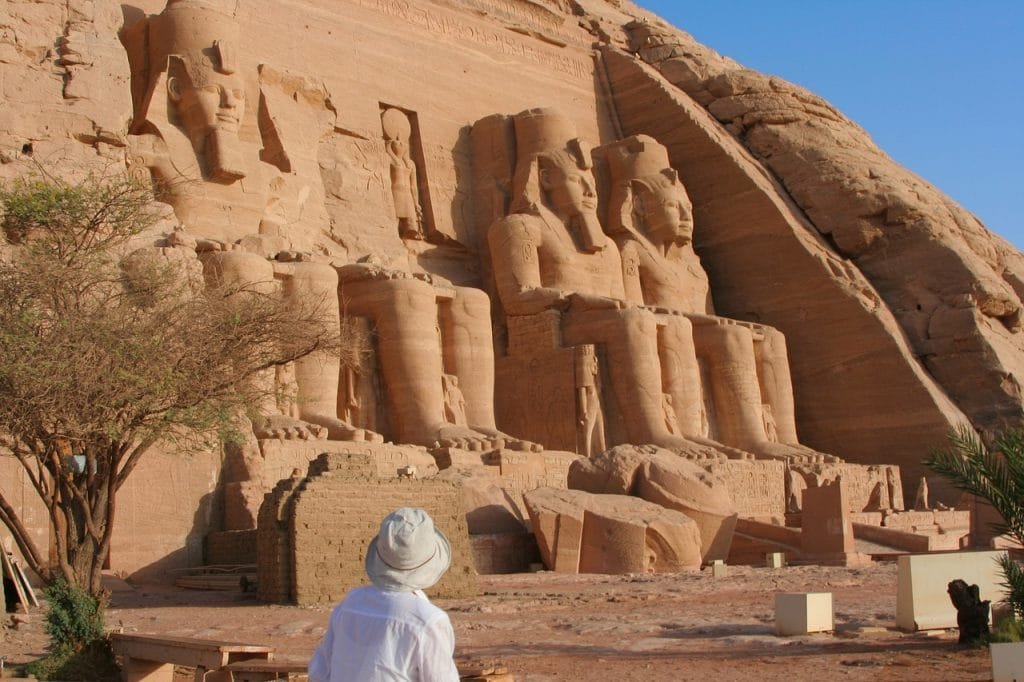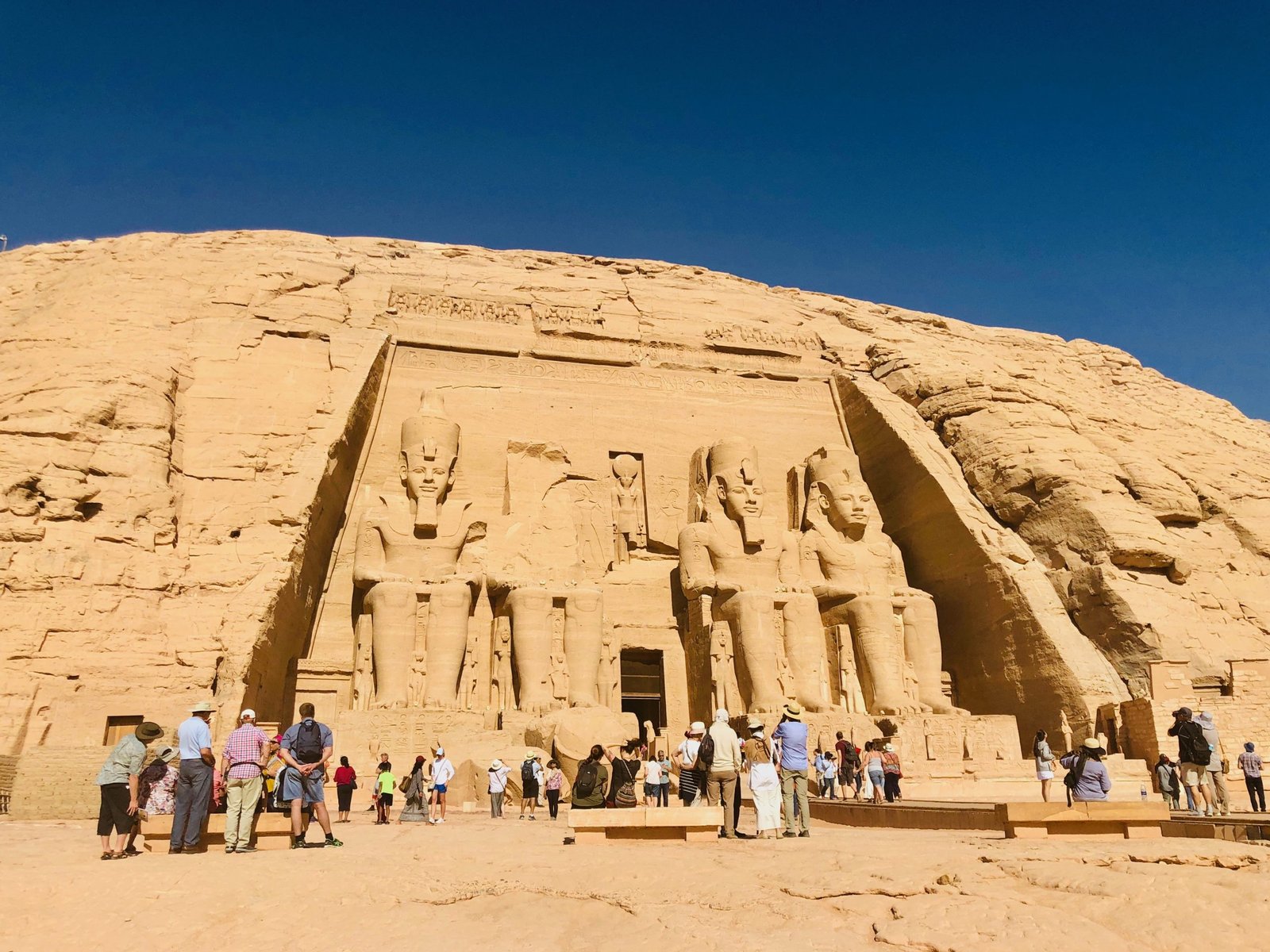Click here to Choose your Next Cheap Tour To Egypt The Price Starts From $22
Abu Simbel Temple is truly an amazing site to behold! Located in the Nubian desert near the southern border with Sudan, this archaeological wonder was built during the reign of Ramses II in the 13th century BC. The two main temples – the Great Temple of Ramses II and the Temple of Hathor – are a testament to ancient Egyptian architecture, having stood for centuries against all odds. Alongside these impressive structures are several smaller ones that add even more awe-inspiring beauty to this magnificent site. Abu Simbel is definitely worth visiting if you ever get a chance!
Abu Simbel Temple facts
Abu Simbel Temple is truly a marvel to behold. Its grandeur and size are awe-inspiring, with four massive statues of the great king himself carved into its façade that stands over 20 meters tall! It’s even more impressive when you consider that this temple was built in such a way as to capture the first rays of the rising sun on two specific days each year. On February 22nd and October 22nd, which correspond to Ramses’ birthday and coronation respectively, light floods through the temple creating an incredible display of light and shadow inside – it must be quite something to witness!
Abu Simbel Temple is truly a sight to behold! It’s an incredible experience to explore its grand halls and chambers adorned with intricate hieroglyphic inscriptions, vibrant reliefs, and detailed carvings. The Hall of Gods is especially remarkable as it showcases 8 impressive columns decorated with depictions of powerful gods such as Ra, Amun, and Ptah. If you get the chance to visit this majestic temple in person then I highly recommend that you take it – there’s nothing quite like seeing these beautiful pieces of art up close!

Visiting Abu Simbel Temple is a once-in-a-lifetime experience, and there are several questions that visitors may have when planning their trip:
1- How to get there: Abu Simbel Temple is located about 280 km south of Aswan, and visitors can reach the site by car, bus, or plane. Most visitors choose to fly from Aswan, as it is the quickest and most convenient option.
2- When to visit: The best time to visit Abu Simbel Temple is during the winter months (December to February) when the weather is mild and pleasant. However, this is also the busiest time of year, so visitors should expect crowds.
3- What to wear: As with all archaeological sites in Egypt, visitors should dress modestly, covering their shoulders and knees. Comfortable shoes are also recommended, as there is a lot of walking involved.
4- Entry fees: There is an entry fee for Abu Simbel Temple, which includes access to both temples. The fee is higher for non-Egyptians, and discounts are available for students and children.
5- Photography: Photography is allowed at Abu Simbel Temple, but visitors should be aware that flash photography is prohibited inside the temples. Tripods and selfie sticks are also not allowed.

How long did it take to build Abu Simbel Temple?
The Great Temple of Ramses II at Abu Simbel Temple and the Temple of Hathor are incredible feats of engineering, built by an ancient civilization with skill and precision. It is estimated that it took approximately 20 years to construct the larger temple, beginning in year 24 of Ramses II’s reign and finishing around his 44th year. The construction time for the smaller temple is less clear but believed to be completed in less than 10 years during Pharaoh Merneptah’s reign. Unfortunately, there are no surviving records detailing how long these impressive structures took to build or what processes were used; however, their presence today stands as a testament to the ingenuity and hard work put into them by those who came before us!
Where was Abu Simbel Temple originally located?
The original location of Abu Simbel Temple is a fascinating part of history. It was situated on the banks of the Nile River in southern Egypt, near the border with modern-day Sudan, and in an area known as Nubia which was historically inhabited by Nubian people. The temples at Abu Simbel were built by Pharaoh Ramses II during the 13th century BC and were part of a larger complex that included tombs along its banks.
Unfortunately, when Lake Nasser formed due to construction on Aswan High Dam in the 1960s, it threatened to submerge this ancient site forever! Thankfully though, UNESCO led an international effort to relocate these incredible monuments so they could be preserved for future generations – what an amazing rescue mission!
Why is the Abu Simbel temple important?
- Historical significance: Ramses II, one of the most powerful and important pharaohs in ancient Egypt, oversaw the construction of the Abu Simbel temple. The temple serves as a reminder of the magnificence and refinement of ancient Egyptian civilization as well as the pharaohs’ enormous riches and power.
- Artistic and architectural achievements: The Abu Simbel temple is a truly magnificent sight to behold! Its impressive architectural design and artistic beauty have made it renowned throughout the world.
- Religious significance: The Abu Simbel temple is an incredible testament to the religious beliefs and culture of ancient Egypt. Built as a monument to honor the gods and goddesses, it was specifically dedicated to Ra-Horakhty, god of the sun, and Ramses II himself who was considered a god-king by his people. It stands today as an impressive reminder of their faith in divine powers which still inspires awe thousands of years later.
- Cultural heritage: The Abu Simbel temple is an incredible example of Egypt’s cultural heritage and it is no wonder that it has been recognized as a UNESCO World Heritage site. It truly stands out in its beauty, drawing thousands of tourists from all over the world each year. Not only does this contribute to Egypt’s economy, but also promotes cultural exchange between people from different parts of the globe who come together to admire this magnificent structure. Visiting such a place can be an enriching experience for everyone involved!

In summary
Abu Simbel Temple is a must-see destination for anyone interested in ancient Egypt and its incredible architectural achievements. It’s an awe-inspiring sight to behold – the massive statues, intricate hieroglyphics and stunning location on the banks of the Nile make it a true wonder of the ancient world that should not be missed.
With so much history and culture encapsulated within this temple complex, it’s no surprise that Abu Simbel has been attracting visitors from all over for centuries! Whether you’re looking to explore antiquities or just appreciate some remarkable engineering feats, there’s something here for everyone – don’t miss out on your chance to experience this amazing place firsthand!
Our knowledgeable guides will be able to provide you with detailed information about the Abu Simbel temple, as well as other interesting facts about Egypt’s rich history throughout your journey. Join us on this unforgettable experience today!

